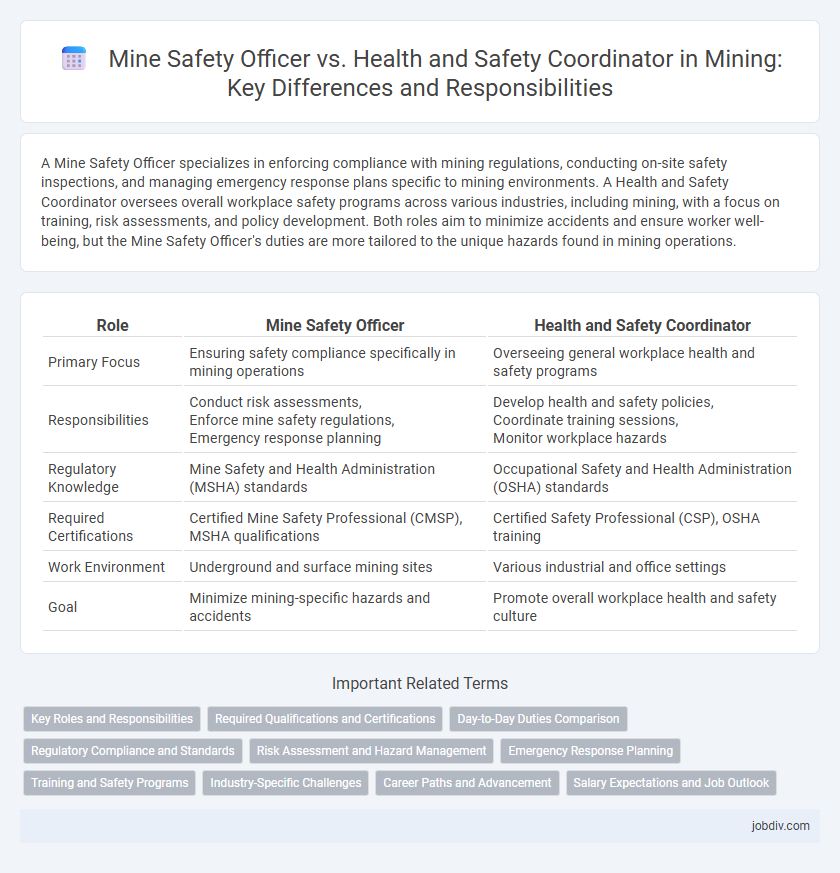A Mine Safety Officer specializes in enforcing compliance with mining regulations, conducting on-site safety inspections, and managing emergency response plans specific to mining environments. A Health and Safety Coordinator oversees overall workplace safety programs across various industries, including mining, with a focus on training, risk assessments, and policy development. Both roles aim to minimize accidents and ensure worker well-being, but the Mine Safety Officer's duties are more tailored to the unique hazards found in mining operations.
Table of Comparison
| Role | Mine Safety Officer | Health and Safety Coordinator |
|---|---|---|
| Primary Focus | Ensuring safety compliance specifically in mining operations | Overseeing general workplace health and safety programs |
| Responsibilities |
Conduct risk assessments, Enforce mine safety regulations, Emergency response planning |
Develop health and safety policies, Coordinate training sessions, Monitor workplace hazards |
| Regulatory Knowledge | Mine Safety and Health Administration (MSHA) standards | Occupational Safety and Health Administration (OSHA) standards |
| Required Certifications | Certified Mine Safety Professional (CMSP), MSHA qualifications | Certified Safety Professional (CSP), OSHA training |
| Work Environment | Underground and surface mining sites | Various industrial and office settings |
| Goal | Minimize mining-specific hazards and accidents | Promote overall workplace health and safety culture |
Key Roles and Responsibilities
A Mine Safety Officer enforces regulatory compliance and hazardous condition inspections, specializing in underground and surface mining operations to prevent accidents. In contrast, a Health and Safety Coordinator develops safety programs, conducts risk assessments, and facilitates worker training across broader industrial environments, including mines. Both roles emphasize incident investigation and emergency preparedness but differ in scope, with the officer focusing on mine-specific hazards and the coordinator managing overall workplace safety protocols.
Required Qualifications and Certifications
Mine Safety Officers must hold a valid Mine Safety and Health Administration (MSHA) certification along with a degree or diploma in mining engineering or occupational health and safety. Health and Safety Coordinators typically require certifications such as OSHA 30-hour General Industry and first aid/CPR, often supported by a background in environmental health or industrial hygiene. Both roles demand comprehensive knowledge of mining regulations, emergency response protocols, and risk management practices to ensure workplace safety compliance.
Day-to-Day Duties Comparison
Mine Safety Officers conduct regular inspections and risk assessments to ensure compliance with mining safety regulations, focusing on hazard identification and emergency preparedness. Health and Safety Coordinators manage workplace safety programs by developing training sessions, monitoring injury reports, and coordinating with supervisors to implement safety improvements. Both roles require close interaction with workers but differ as Safety Officers emphasize enforcement and incident investigation, while Coordinators prioritize education and ongoing safety program management.
Regulatory Compliance and Standards
Mine Safety Officers enforce regulatory compliance by conducting regular inspections and ensuring adherence to mining safety standards set by authorities such as MSHA (Mine Safety and Health Administration). Health and Safety Coordinators develop and implement comprehensive safety programs, aligning company policies with OSHA (Occupational Safety and Health Administration) regulations to maintain workplace hazard controls. Both roles collaborate to uphold industry-specific safety standards, minimize risks, and ensure legal compliance within mining operations.
Risk Assessment and Hazard Management
Mine Safety Officers specialize in conducting comprehensive risk assessments and implementing site-specific hazard management strategies to ensure compliance with mining regulations. Health and Safety Coordinators focus on developing and overseeing safety programs, promoting worker education, and coordinating hazard identification efforts across multiple operational areas. Effective risk assessment in mining requires synergy between both roles to minimize workplace incidents and enhance overall safety performance.
Emergency Response Planning
A Mine Safety Officer specializes in developing and implementing emergency response plans tailored to underground and surface mining operations, ensuring compliance with mining regulations such as MSHA standards. Health and Safety Coordinators focus more broadly on workplace safety across various industries, coordinating emergency response protocols, training, and drills to mitigate risks. In mining, the Mine Safety Officer's expertise is crucial for addressing site-specific hazards and coordinating rapid response efforts during incidents like collapses, fires, or gas leaks.
Training and Safety Programs
Mine Safety Officers specialize in implementing comprehensive safety training programs tailored to mining operations, ensuring compliance with regulatory standards and reducing workplace hazards. Health and Safety Coordinators focus on developing and coordinating broad safety initiatives across multiple departments, emphasizing worker health, emergency response, and ongoing education. Both roles are critical in fostering a culture of safety through regular training sessions, hazard assessments, and continuous improvement of safety protocols in the mining industry.
Industry-Specific Challenges
Mine Safety Officers specialize in identifying and mitigating hazards unique to underground and surface mining operations, including handling explosive materials, gas monitoring, and ensuring compliance with mining regulations like MSHA standards. Health and Safety Coordinators focus on broader occupational safety protocols across various mining sites, managing risk assessments, emergency response planning, and promoting worker health through ergonomic and environmental controls. Both roles address industry-specific challenges such as dust management, equipment safety, and site-specific hazard training, but Mine Safety Officers have a deeper expertise in technical mining safety issues.
Career Paths and Advancement
Mine Safety Officers specialize in enforcing regulatory compliance and conducting safety inspections within mining operations, often advancing to senior supervisor or regulatory roles. Health and Safety Coordinators focus on developing and implementing workplace safety programs across various industries, with career progression leading to safety management or consultancy positions. Both roles require expertise in occupational health regulations, but Mine Safety Officers typically have a more technical and site-specific career path compared to the broader scope of Health and Safety Coordinators.
Salary Expectations and Job Outlook
Mine Safety Officers typically earn an average salary ranging from $60,000 to $85,000 annually, with salaries influenced by experience, location, and certification levels. Health and Safety Coordinators in mining tend to have a slightly lower salary range, averaging between $50,000 and $75,000 per year, reflecting their broader but less specialized responsibilities. Job outlook for both positions remains strong due to stringent regulatory requirements and ongoing industry emphasis on workplace safety improvements.
Mine Safety Officer vs Health and Safety Coordinator Infographic

 jobdiv.com
jobdiv.com